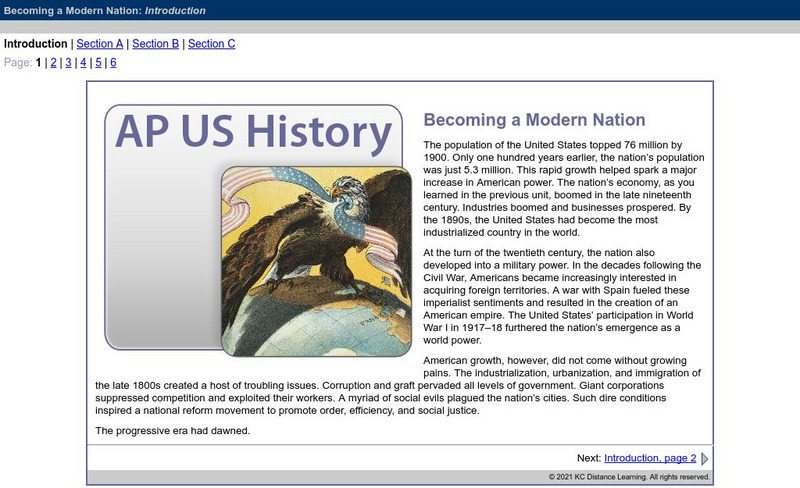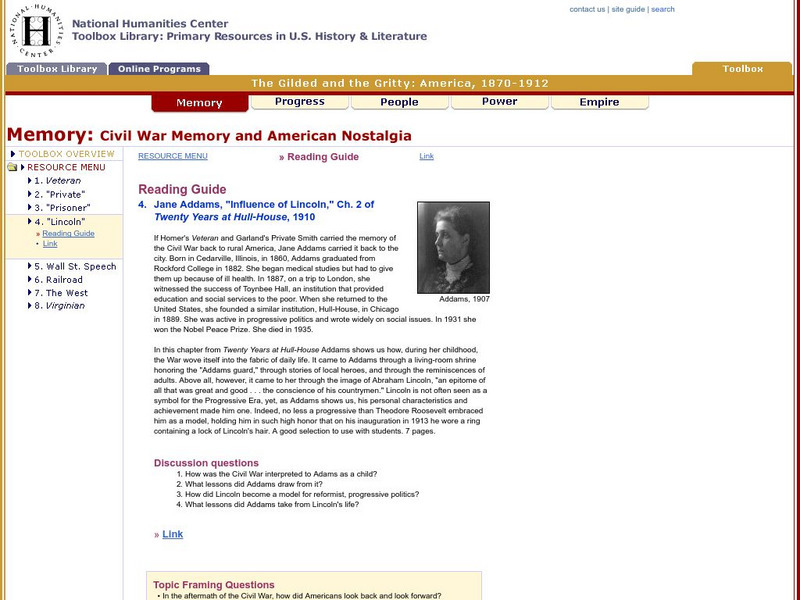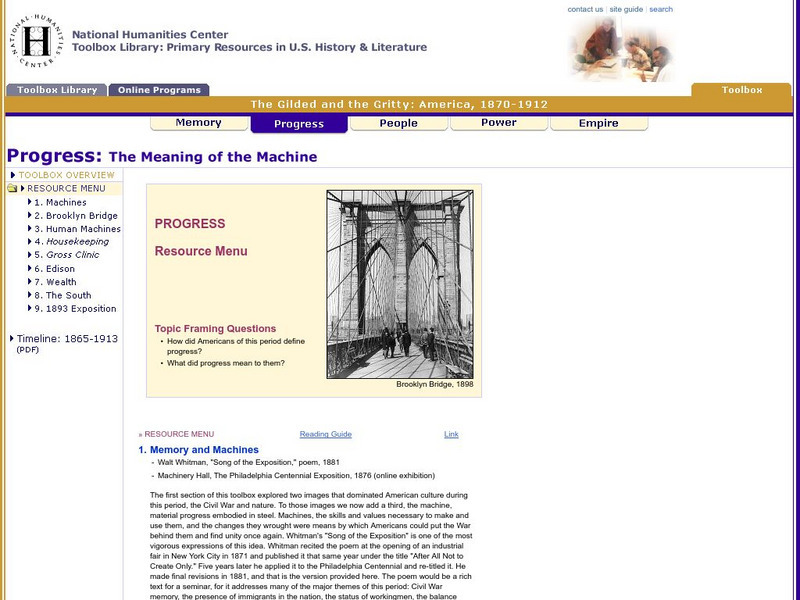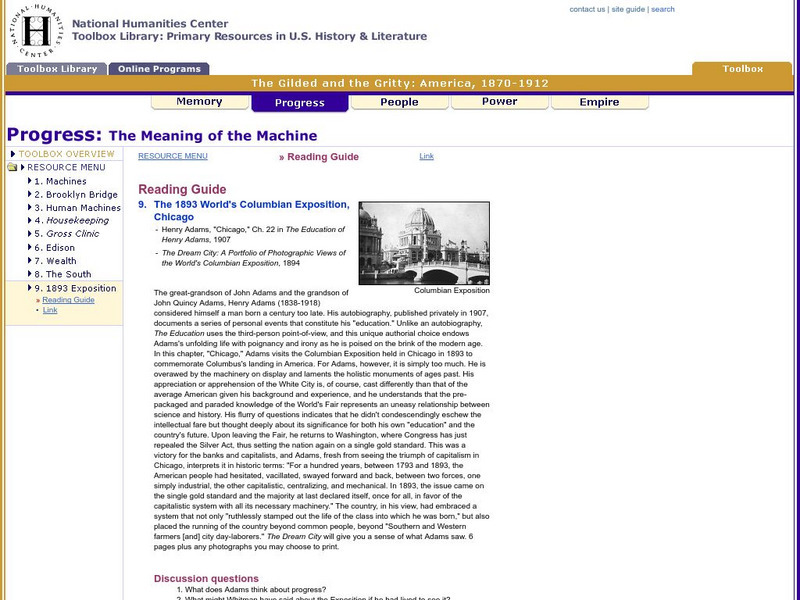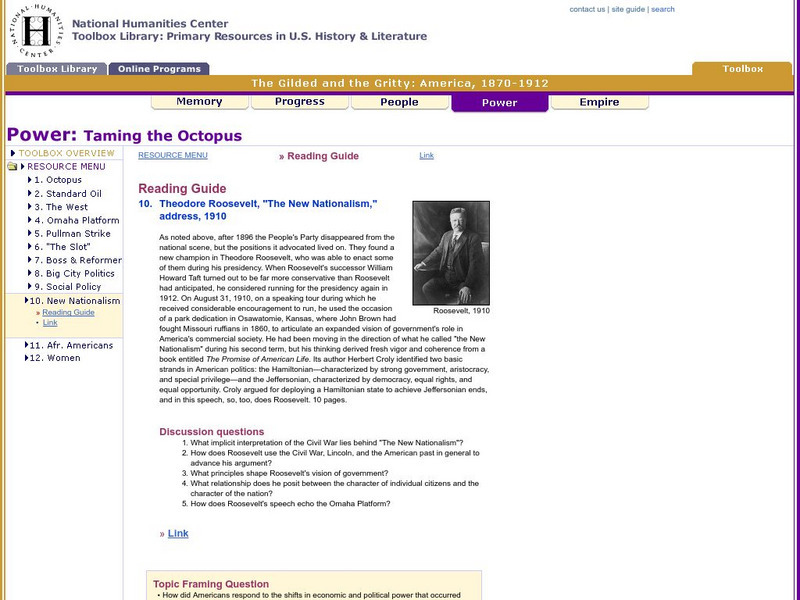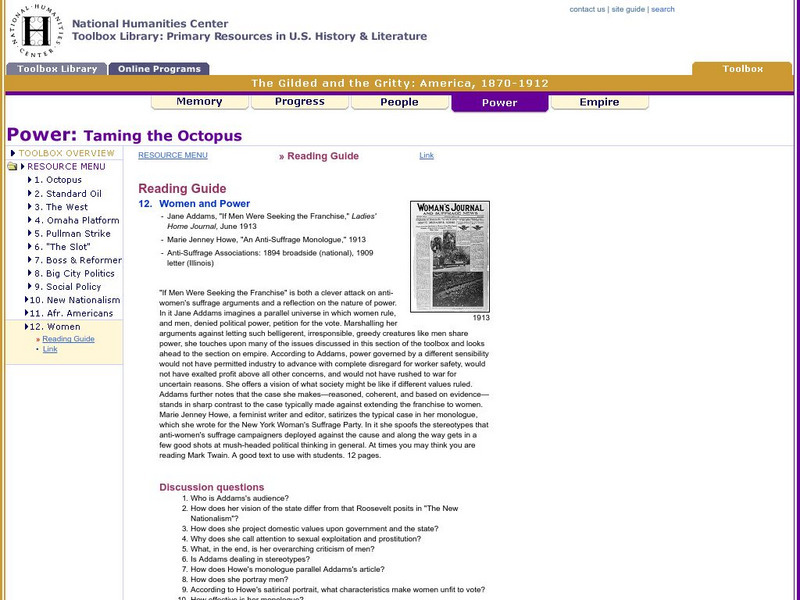University of Minnesota
The Fourteenth Amendment and the Rights Revolution: Muller v. Oregon
In the Progressive Era many states passed laws to protect workers and establish decent working conditions. Read the text of Muller v. Oregon, heard before the Supreme Court in 1908, that upheld Oregon's laws as constitutional.
PBS
Pbs Learning Media: Primary Source: Environmental Preservation Progressive Era
This collection uses primary sources to environmental preservation in the Progressive Era.
Library of Congress
Loc: Mary Church Terrell Papers
The papers of educator, lecturer, suffragist, and civil rights activist Mary Church Terrell consist of approximately 13,000 documents. Spanning the years 1851 to 1962, with the bulk of the material concentrated in the period 1886-1954,...
CK-12 Foundation
Ck 12: Epsid 2019 2020 Us History
Flexbooks 2.0 are interactive, customizable, digital textbooks. Flexbooks are standards-aligned. Flexi, a student tutor, is integrated into each book to guide you on your learning journey. Flexi can assist in learning, answer questions,...
National Women’s History Museum
National Women's History Museum: The Triangle Shirtwaist Fire
Student will use primary and secondary sources to gain a richer understanding of women's activism and how the Triangle Shirtwaist Fire led to changes in labor and safety regulations in America.
Department of Defense
Do Dea: Ap Us History: Unit 6: Becoming a Modern Nation
This extensive learning module examines the role of large-scale industrialization, urbanization, and mass migrations in creating new demands on government and social organizations to design reforms, and looks at the global and domestic...
Khan Academy
Khan Academy: Ap Us History Unit: Period 7: 1890 1945: The Progressives
This practice exercise from Khan Academy covers Period 7: 1890-1945 in American History. The Progressive Era is reviewed in this resource. This resource is designed as a review for the AP US History Test.
Khan Academy
Khan Academy: Ap Us History History Unit: Period 7: 1890 1945: Teddy Roosevelt
The study resource from Khan Academy provides an overview of Period 7: 1890-1945 in American History. The Presidency of Theodore Roosevelt is discussed in this lesson. This resource is designed as a review for the AP US History Test.
Khan Academy
Khan Academy: Ap Us History Unit: Period 7: 1890 1945: The Progressive Era
The study resource from Khan Academy provides an overview of Period 7: 1890-1945: The Progressive Era. An overview of an Progressive Era is provided. This resource is designed as a review for the AP US History Test.
Khan Academy
Khan Academy: Ap Us History Unit: Period 7: 1890 1945: Muckrakers
The study resource from Khan Academy provides an overview of Period 7: 1890-1945 in American History. The Progressive Era's muckrakers are discussed in this lesson. This resource is designed as a review for the AP US History Test.
Library of Congress
Loc: Confrontations, Sacrifice, and the Struggle for Democracy
Learn how women fought for the right to vote and the work of the National Woman's Party(NWP).
Thinkport Education
Thinkport: Progressive Era? What Does That Mean?
In this activity, students use strategies to determine the meaning of unfamiliar words and phrases that describe political, social or economic aspects of the Progressive Era.
National Humanities Center
National Humanities Center: Toolbox Library: The West, the Gilded and the Gritty: America, 1870 1912
Four nineteenth-century landscape paintings that suggest the meaning of the West in American life.
National Humanities Center
National Humanities Center: Toolbox Library: The Gilded and the Gritty: America, 1870 1912
Ninety-four primary sources-historical documents, literary texts, and visual images-that explore the challenges, opportunity, and turmoil of late-nineteenth-century America. They examine the economic expansion in an America re-united...
National Humanities Center
National Humanities Center: Toolbox Library: Memory, the Gilded and the Gritty: America, 1870 1912
Twelve primary sources - historical documents, literary texts, and visual images - that explore ways in which the memory of the Civil War affected American life in the last quarter of the nineteenth century.
National Humanities Center
National Humanities Center: Toolbox Library: Memory: Civil War Memory and American Nostalgia: Influence of Lincoln
An excerpt from Jane Addams' autobiography "Twenty Years at Hull House" that describes how Abraham Lincoln inspired her urban reform efforts.
National Humanities Center
National Humanities Center: Toolbox Library: Railroad, the Gilded and the Gritty: America, 1870 1912
A speech and an engraving that illustrate how the railroad helped to unite the country after the Civil War.
National Humanities Center
National Humanities Center: Toolbox Library: Progress, the Gilded and the Gritty: America, 1870 1912
Eighteen primary sources-historical documents, literary texts, and visual images-that explore the industrial, racial, and technological progress of the late-nineteenth century.
National Humanities Center
National Humanities Center: Toolbox Library: Gross Clinic, the Gilded and the Gritty: America, 1870 1912
Thomas Eakins's controversial painting that reflects the skill of professional, scientific practitioners during the late-nineteenth century.
National Humanities Center
National Humanities Center: Toolbox Library: The Meaning of the Machine: The 1893 World's Columbian Exposition
Two views of late-nineteenth-century American progress: Henry Adams criticizes it in his autobiography, and the Columbian Exposition of 1893 praises it.
National Humanities Center
National Humanities Center: Toolbox Library: Power: Taming the Octopus: The Image of the Octopus
Six versions of the octopus, a pervasive image in late-nineteenth-century America, that illustrate the extensive and corrosive power held by corporations over American political and economic life. Reading guide with discussion questions.
National Humanities Center
National Humanities Center: Toolbox Library: Big City Politics, the Gilded and the Gritty: America, 1870 1912
Ash Can School artist John Sloan's painting Election Night captures the exuberance of urban politics in the early-twentieth century, and artist Henry Glitkencamp's illustration Voting Machines suggests its corrupting power. Both pieces...
National Humanities Center
National Humanities Center: Toolbox Library: Power: Taming the Octopus: Theodore Roosevelt, the New Nationalism
Theodore Roosevelt's speech in 1910 arguing for the vigorous involvement of government in American life.
National Humanities Center
National Humanities Center: Toolbox Library: Women, the Gilded and the Gritty: America, 1870 1912
Arguments by women for and against the extension of the vote to women. This resource primarily focuses on, "If Men Were Seeking the Franchise," by Jane Addams, used to project domestic values upon government and the state.


